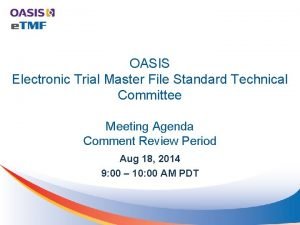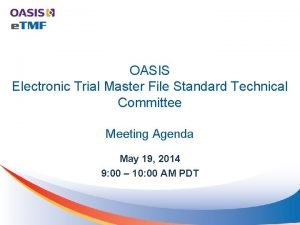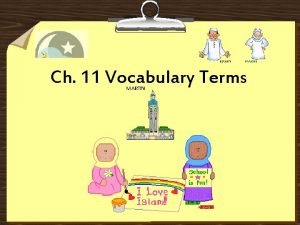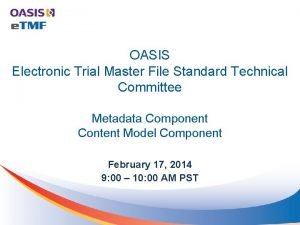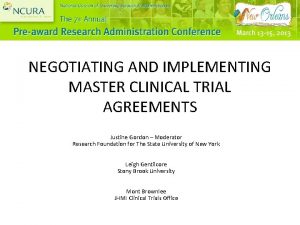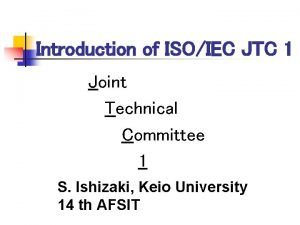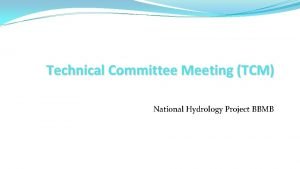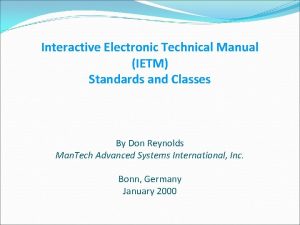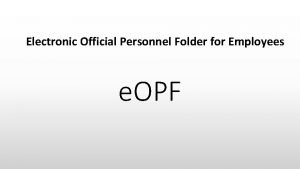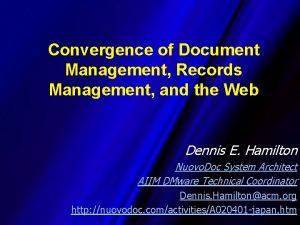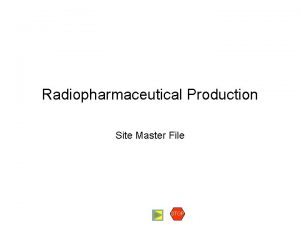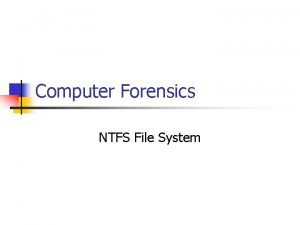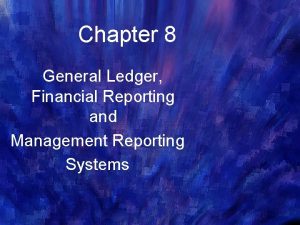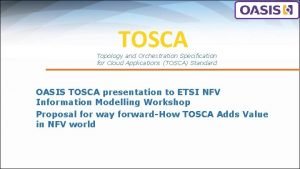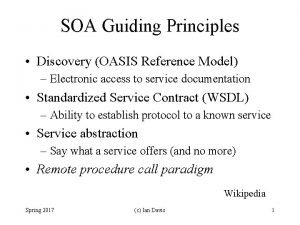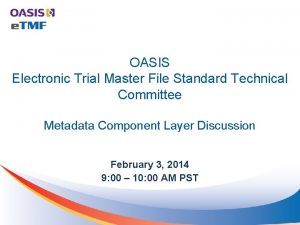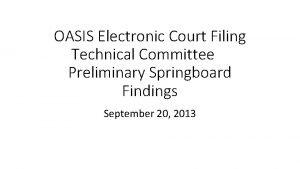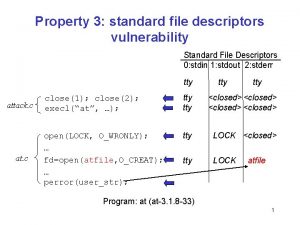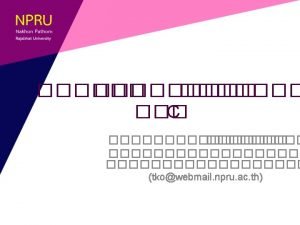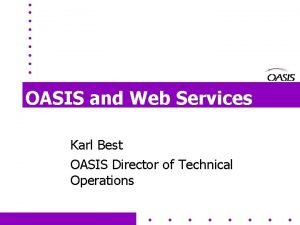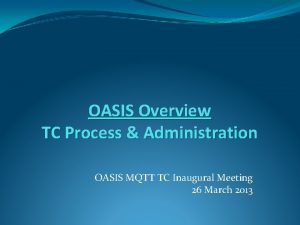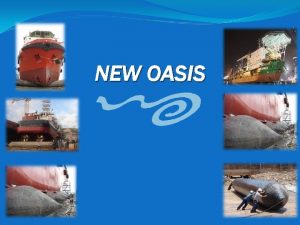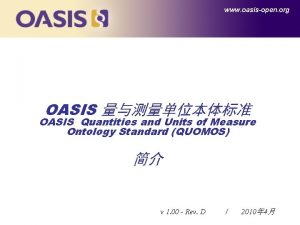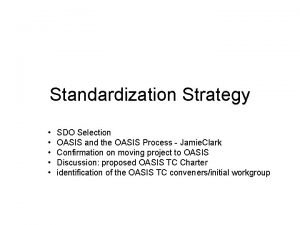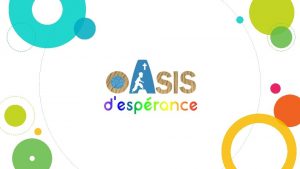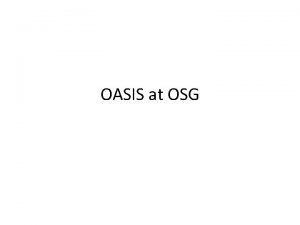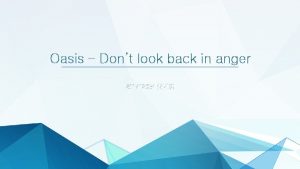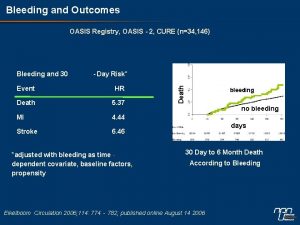OASIS Electronic Trial Master File Standard Technical Committee
























- Slides: 24

OASIS Electronic Trial Master File Standard Technical Committee Content Classification Layer January 20, 2014 9: 00 – 10: 00 AM PST

Agenda Topic 9: 00 -9: 05 Call to Order & Roll Call 9: 05 -9: 10 Approval of Minutes https: //www. oasisopen. org/committees/documents. php? wg_abbrev=etmf Presenter Zack Schmidt All TC Process and Administration (deferred) Chet Ensign 9: 10 -9: 20 Outreach Subcommittee - All Jennifer Alpert 9: 20 -9: 50 Tech presentation – Content Classification Layer Z. Schmidt/Aliaa 9: 50 -9: 55 New Business All 9: 55 -10: 00 Next meeting agenda / Date Z. Schmidt 2

Roll Call Name Company Voting Status Present? Jennifer Alpert Palchak Care. Lex Voter y Aliaa Badr Care. Lex Voter y Oleksiy (Alex) Palinkash Care. Lex Voter y Troy Jacobson Forte Research Voter y Lou Chappuie Individual Voter y Lisa Mulcahy Individual Non-Voter y Robert Gehrke Mayo Clinic Voter n Rich Lustig Oracle Non-Voter y Michael Agard Paragon Solutions Non-Voter y Christopher Mc. Spiritt Paragon Solutions Non-Voter y Jamie O’Keefe Paragon Solutions Non-Voter n Fran Ross Paragon Solutions Non-Voter y Peter Alterman SAFE-Bio. Pharma Voter y Catherine Schmidt Sterling. Bio Voter y Zack Schmidt Sure. Clinical Voter y Trish Whetzel, Ph. D Sure. Clinical Non-Voter y Peter Junge Beijing Sursen Observer n Laura Hilty Forte Research Observer n Tony O’Hare Forte Research Observer n Eldin Rammell Consulting Observer n Robin Cover OASIS staff Non-Voter n Chet Ensign OASIS staff Non-Voter n

Meeting Etiquette • Announce your name prior to making comments or suggestions • Keep your phone on mute when not speaking (#6) • Do not put your phone on hold – Hang up and dial in again when finished with your other call – Hold = Elevator Music = very frustrated speakers and participants • Meetings will be recorded and posted – Another reason to keep your phone on mute when not speaking! • Use the join. me “Chat” feature for questions / comments / Votes • NOTE: We will Robert’s Rules of Order Thisfollow meeting is being recorded and minutes will be posted on TC page after the meeting 4 From e. TMF Std TC to Participants: Hi everyone: remember to keep your phone on mute

Outreach Subcommittee • Status – New Members: – Oracle – Joined – In Progress: EMC, Kaiser Permanente, Shire, Medtronics • Activities / Milestones

Tech Discussion • Status • Timeline • In parallel with other Tech work from charter

Content Classification System Discussion – Classification System Components: • Classification Categories – Taxonomy, hierarchy • Metadata (‘Tags’) – Characterizes content • Content Model – Published set of classifications, metadata for a domain (e. g. , e. TMF)

Classification Categories Component – Hierarchy of categories • Classification Categories Hierarchy Categories, subcategories, content types – Defined relationships with rules: Parent-Child – All categories, content types required to have unique names and machine codes – Each content type is associated with Metadata Properties (includes core and domain-specific) – Content items are linked to content types. – Unique classification and term codes based on Universal Decimal Classification System (UDC) numbering, widely used in libraries worldwide. Human and machine readable; infinitely expandable – Can be described, edited and validated using OWL editor (like open source editor Protégé’) – Supports any simple text vocabulary, including TMF Ref Model and other vocabularies – W 3 C OWL 2 and RDF/XML supported Study Digital Content

Metadata Component – Used to tag or index digital content items Metadata Classes: Core - Comprised of four areas: File Properties, Classification, Audit Trail Business Process Domain-specific -- Metadata for a domain in life sciences such as e. TMF, finance, legal administration, or others. Uses standards-based terms from groups like NCI Org Specific – Metadata that meets organizations needs – not standards based General – obtained from public standards-based vocabulary terminology resources like dublin core Annotation Properties Metadata about classification categories and metadata: § Core, Org-Specific metadata Core Metadata Example – File Properties:

Content Model Component – Contains classification hierarchy, metadata in machine readable format:

Classification System – Term Sources Term Sourcing Concepts: • Terms adopted by standards bodies should be used first in e. TMF model Primary Term Sources for e. TMF Classification System: – Internet Standards Dev Orgs: W 3 C, IETF, ISO, etc. » Required for interoperability of machine code – NIH NCIthesaurus: Term database for FDA, CDISC, HL 7, other orgs » Required for interoperability of clinical / health sciences data Secondary Term Sources for e. TMF Classification System: • Industry sources – widely used terms in enterprise content mgmt software, TMF RM *Spec, Table 6, p 21

Classification Categories Component – Classification hierarchy and numbering is based on UDC library numbering standard and XML naming – Digital dot notation – Designed for human and machine readability – Each number is also a unique code for naming and ordering in the hierarchy – Primary Categories (PC): Three digit. e. TMF: 100 -200 – Subcategories (SC): Two digit: 10 -99 Hierarchy Numbering/Naming Considerations: – Content Types (CT): Two digit: 10 -99 – Maximum number of Sub. Category divisions is 5, excluding the 3 -digits for the Primary Category [1] Per spec section 2. 1. 1; 6. 0 Classification Categories Hierarchy and Numbering [1]: : • • • Flexible, standards-based approach (W 3 C XML compliant naming*) Ability to add multiple hierarchy divisions / levels 5 11 • Proposed: 5 divisions = [100*90 ) = 5. 9 x 10 Content Types Uniqueness of numbers – usable as machine code identifiers Machine readable, human readable No sorting issues, no need for leading zeros*, no special chars *Leading zeros in XML syntax are ignored: http: //www. w 3. org/TR/REC-xml/

Classification Categories Component Numbering and Naming Scheme Numbering • Primary Categories and Sub-Categories : – Category Code number • Content Type: – Content Type ID Naming • Primary Categories and Sub-Categories – Simple text-based names – Unique name, 64 char limit – Abbreviation – 16 char limit suggested – Compatible with W 3 C XML naming standards : No special characters : ()< > ? /%# @! Example: Classification Categories Hierarchy, Naming, Numbering

Classification Categories Component Modifying Classification Category Entities – General Editing Rules Domain Specific Classification Category, Content Type Editing Rules* – Classifications cannot be deleted –> Reserve/Unreserve Type Import Terms Generate Code Add/Modify Delete/Reserve Domain Specific Yes No No/Yes** Reserve/Unreserve Organization Specific Yes Yes/Yes Delete – Modifications allowed to some annotation properties (see spec) – Codes (Category Codes, CT Type ID) cannot be generated Organization Specific – Classifications can be deleted – Modifications allowed for classification metadata, annotations – Codes (Category Codes, CT Type ID) can be generated *Spec, Table 6, p 21 **Annotation metadata

Classification Editing Tool – Free, Open Source Protégé (From Stanford University: http: //protege. stanford. edu/ ) Protégé Editor: -Edit Classification Taxonomy and Metadata Terms -Validate Taxonomy and Term name compliance -Create valid RDF/XML Ontology *Spec, Table 6, p 21

Classification Categories - Summary Proposed Classification System has following Properties: • Based on Naming and Numbering that is W 3 C XML compliant – No special characters: ( ) & # @ / … etc. – No leading zeros in classification numbers • Based on Universal Decimal Classification (UDC) system for content classification: – 100 199 : e. TMF Domain – UDC system used in 170+ countries worldwide; expandable, human and machine readable, sortable http: //en. wikipedia. org/wiki/Universal_Decimal_Classification • Flexible and customizable for organizations, yet interoperable – Domain classifications – Standardized; Organization-specific classifications – Editable • Defined set of rules for Editing, modifying Taxonomy • Any Organization can Modify/Edit taxonomy using open source editors like Protégé *Spec, Table 6, p 21

Appendix

Classification System – Core Terms Content Classification System – Core Terms needed for Architecture – Objectives: • Classification, Subclassification concept - – Supports RDF/XML, OWL languages – Non-domain specific, generic terms – Easily understandable by anyone - conveys concept – Conveys hierarchy – No conflicts – not a reserved term in RDF/XML, OWL or other compilers/ IDE’s – First priority – Source terms from standards bodies *Spec, Table 6, p 21

Classification System – Core Terms Content Classification System – Core Terms needed for Architecture • Classification, Subclassification term concept: Term Options: Source Definition Category, Sub. Category NIH NCIthesaurus Category: ‘This term is used informally to mean a class of things’ (NCI code: C 25372); Subcategory: ‘A subdivision that has common differentiating characteristics within a larger category. ’ (NCI Code C 25692) Class, Sub. Class W 3 C OWL Class: ‘Resources may be divided into groups called classes’ Sub. Class: ‘Subclasses are classes; If a class C is a subclass of a class C', then all instances of C will also be instances of C'. (W 3 C RDF Class def) TMF Zone, Section TMF Ref Model TMF Zone = Primary Classification (no published def found online) Section = Sub. Classification (no published def found online) Proposed Term *Spec, Table 6, p 21

Classification System – Core Terms Content Classification System – Core Terms needed for Architecture • Classification, Subclassification term concept: Term Options: Source +/- Category, Sub. Category NIH NCIthesaurus +Everyone knows it +Describes hierarchy +In use by standards body (NIH NCI Thesaurus) +Generic Class, Sub. Class W 3 C OWL +Describes hierarchy +In use by standards body +Generic - Could be a reserved word for some development tools TMF Zone, Section TMF Ref Model +In use by TMF RM users -Doesn’t convey hierarchy -Not in use by standards body -Not Generic Proposed Term *Spec, Table 6, p 21

Classification System – Core Terms Content Classification System – Core Terms needed for Architecture – Objectives: • Content Type concept – Supports RDF/XML, OWL languages – Non-domain specific, generic terms – Easily understandable by anyone – conveys concept – No conflicts – not a reserved term in RDF/XML, OWL or other compilers/ IDE’s – First priority – Source terms from standards bodies *Spec, Table 6, p 21

Classification System – Core Terms Content Classification System – Core Terms needed for Architecture • Content Type term concept: Term Source Definition Content Type W 3 C & Care. Lex Oracle W 3 C: ‘Specifies the nature of a linked resource’ W 3 C and Proposed Term RFC 2045] and [RFC 2046] Care. Lex: A content type is a reusable collection of metadata, business processes, behavior, and other settings for a category of items or documents in electronic content material. Oracle: Content types are used to define the metadata that you can associate with content. *Spec, Table 6, p 21 Artifact TMF Ref Model ‘A collection of documents’ Wikipedia (Not published)

Classification System – Core Terms Content Classification System – Core Terms needed for Architecture • Content Type term concept: Proposed Term *Spec, Table 6, p 21 Term Source +/- Content Type W 3 C +Widely used in internet SW +ECM SW use - Microsoft, Oracle, Alfresco, etc. +In use by standards body (W 3 C) +Generic Artifact TMF Ref Model +In use by TMF RM users -Not in use by standards body -Not Generic -Doesn’t convey concept of metadata

Draft Agenda: Next Meeting • Roll call • Reports – Outreach – Tech Discussion: Classification Layer: Core Metadata (Charter item 2, p. 2) • New business
 Electronic trial master file definition
Electronic trial master file definition Electronic trial master file definition
Electronic trial master file definition A desert herder who traveled from oasis to oasis
A desert herder who traveled from oasis to oasis Trial master file contents
Trial master file contents File-file yang dibuat oleh user pada jenis file di linux
File-file yang dibuat oleh user pada jenis file di linux Master clinical trial agreements
Master clinical trial agreements Joint technical committee 1
Joint technical committee 1 Technical committee on customs valuation
Technical committee on customs valuation Tcm technical committee meeting
Tcm technical committee meeting Is the electronic exchange of money or scrip
Is the electronic exchange of money or scrip Electronic news gathering and electronic field production
Electronic news gathering and electronic field production Interactive electronic technical manual
Interactive electronic technical manual Electronic official personnel file
Electronic official personnel file Electronic file management
Electronic file management Difference between logical file and physical file
Difference between logical file and physical file Fungsi dari create file pada operasi-operasi file (cont.)
Fungsi dari create file pada operasi-operasi file (cont.) Remote file access in distributed file system
Remote file access in distributed file system Markup tag tells the web browser
Markup tag tells the web browser In a file-oriented information system, a transaction file
In a file-oriented information system, a transaction file Production stop
Production stop Mft entry structure
Mft entry structure An advantage of a batch general ledger system (gls) is that
An advantage of a batch general ledger system (gls) is that Hod management plan template
Hod management plan template Tosca orchestration
Tosca orchestration Oasis reference model
Oasis reference model
